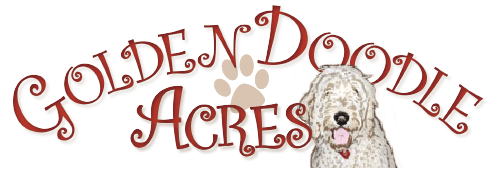
 What About Allergies?
What About Allergies?
If your family has allergies, choosing the right type of Goldendoodle is very important.
Not all Doodles are equally allergy-friendly — it depends on their coat type and genetic makeup.
 Shedding and Coat Types
Shedding and Coat Types
Some Goldendoodles, like F1s (first-generation), or those with improper coats, tend to shed more.
Dogs with Furnishings (the trait that gives that classic “Doodle look” with facial hair and a fluffy coat) typically shed much less.
In general:
- F1 Goldendoodles → higher chance of shedding
- Multigenerational Goldendoodles → generations of low- to no-shed genetics
To better predict coat type and shedding, breeders now use a new DNA Shedding Test — a game changer for allergy-conscious families!
 The Shedding Test: How It Works
The Shedding Test: How It Works
“The SD locus determines the scale of how much shedding there will be. It is closely tied to the furnishings gene. One copy of the SD variant (SD/n) results in low to moderate shedding. Meanwhile, two copies of the variant (SD/SD) results in the higher propensity to shed. Dogs that are negative for furnishings (n/n) also have a higher propensity to shed, while dogs that are F/F for furnishings are considered to be less prone to shedding. Dogs that are both SD/SD (high shedding) for shedding and negative (n/n) for furnishings are the most prone to shedding while dogs that are n/n for shedding and F/F for furnishings are the least prone to shedding of any genotype. Different combinations of genotypes will result in varying amounts of shedding.”
Possible Results
| Genotype | Description |
|---|---|
| SD/SD | Dog has two copies of the shedding allele. The dog will have a higher propensity towards shedding. |
| n/SD | Dog carries one copy of the shedding allele. The dog will have an average propensity towards shedding. |
| n/n | Dog has no copies of the shedding allele. The dog will have a low propensity towards shedding. |
Reference
Hayward JJ, Castelhano MG, Oliveira KC, Corey E, Balkman C, Baxter TL, Casal ML, Center SA, Fang M, Garrison SJ, Kalla SE, Korniliev P, Kotlikoff MI, Moise NS, Shannon LM, Simpson KW, Sutter NB, Todhunter RJ, Boyko AR. Complex disease and phenotype mapping in the domestic dog. Nat Commun 2016 Jan; 7:10460. [PubMed: 26795439]
Because Goldendoodles come from both shedding (Golden Retriever) and non-shedding (Poodle) backgrounds, this test provides far more accurate insight than simply knowing the dog’s generation (F1, F1B, Multigen, etc.).
 Do I Need a Curly Coat for My Allergies?
Do I Need a Curly Coat for My Allergies?
Not anymore!
In the past, people believed that allergy sufferers needed a curly-coated F1B Goldendoodle (75% Poodle, 25% Golden Retriever) to ensure low or no shedding.
Thanks to the new shedding DNA test, breeders can now carefully pair parents based on their shedding scores — creating puppies that are low- to no-shed, even with straight, wavy, or curly coats.
In fact, multigenerational Goldendoodles often bring more Golden Retriever traits and hybrid vigor, while still maintaining the low-shed coat allergy-sensitive families love.
 Important Note About Allergies
Important Note About Allergies
Even if a dog doesn’t shed, it’s still possible to be allergic.
Allergies are caused by certain proteins that dogs produce — found in their skin cells (dander), saliva, or urine.
Because every person’s immune system is different, it’s best to consult an allergy specialist to understand your specific sensitivities and whether a Goldendoodle is the right match for your family.